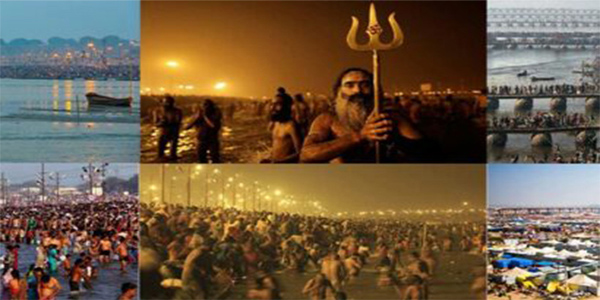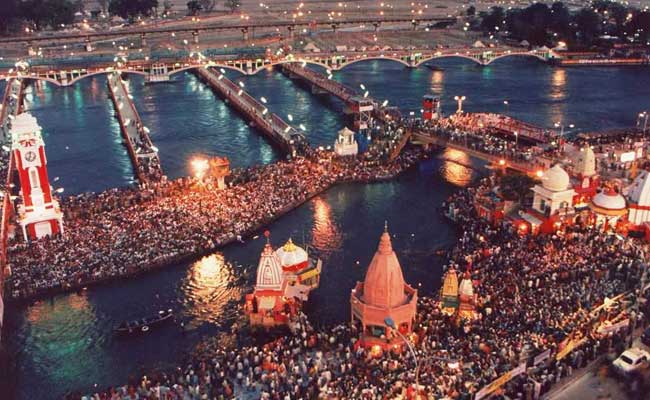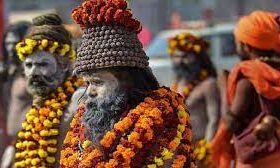The Story of Samudra Manthan
 Indra, the King of Devata’s, while riding on an elephant, came across a sage named Durvasa who offered him a special garland. Indra accepted the garland, placing it on the trunk of the elephant. The elephant, irritated by the smell of the garland, http://localhost:80/kumbh/allahabad-prayagraj-kumbh/ threw it to the ground. This enraged the sage as the garland was a dwelling of Sri (fortune) and was to be treated as Prasad. Durvasa Muni cursed Indra and all devas to be bereft of all strength, energy, and fortune.
Indra, the King of Devata’s, while riding on an elephant, came across a sage named Durvasa who offered him a special garland. Indra accepted the garland, placing it on the trunk of the elephant. The elephant, irritated by the smell of the garland, http://localhost:80/kumbh/allahabad-prayagraj-kumbh/ threw it to the ground. This enraged the sage as the garland was a dwelling of Sri (fortune) and was to be treated as Prasad. Durvasa Muni cursed Indra and all devas to be bereft of all strength, energy, and fortune.
Sagar Manthan
 In battles that followed this incident, Devas were defeated and Asuras (demons) led by king Bali gained control of the universe. Devas sought help from god Vishnu who advised them to treat asuras in a diplomatic manner. Devas formed an alliance with asuras to jointly churn the ocean for the nectar of immortality and to share it among them. However, Lord Vishnu told Devas that he would arrange that they alone obtain the nectar.
In battles that followed this incident, Devas were defeated and Asuras (demons) led by king Bali gained control of the universe. Devas sought help from god Vishnu who advised them to treat asuras in a diplomatic manner. Devas formed an alliance with asuras to jointly churn the ocean for the nectar of immortality and to share it among them. However, Lord Vishnu told Devas that he would arrange that they alone obtain the nectar.
Churning The Milky Ocean
 The churning of the Ocean of Milk or the Milky Way was an elaborate process. Mount Mandarachala was used as the churning rod, and Vasuki, the king of serpents, became the churning rope. The demons (asuras) demanded to hold the head of the snake, while the demigods (devas), taking advice from Vishnu, agreed to hold its tail. As a result the demons were poisoned by fumes emitted by Vasuki. Despite this, the demigods and demons pulled back and forth on the snake’s body alternately, causing the mountain to rotate, which in turn churned the ocean. However, once the mountain was placed on the ocean, it began to sink. Vishnu in his second incarnation, in the form of a turtle Kurma, came to their rescue and supported the mountain on his back.
The churning of the Ocean of Milk or the Milky Way was an elaborate process. Mount Mandarachala was used as the churning rod, and Vasuki, the king of serpents, became the churning rope. The demons (asuras) demanded to hold the head of the snake, while the demigods (devas), taking advice from Vishnu, agreed to hold its tail. As a result the demons were poisoned by fumes emitted by Vasuki. Despite this, the demigods and demons pulled back and forth on the snake’s body alternately, causing the mountain to rotate, which in turn churned the ocean. However, once the mountain was placed on the ocean, it began to sink. Vishnu in his second incarnation, in the form of a turtle Kurma, came to their rescue and supported the mountain on his back.
Halahala (Also Called ‘Kalakuta’)
 Shiva drinking world – poison During the Samudra Manthan by the gods and demons, one of the product emerged from the churning was a dangerous poison (Halahala). This terrified the gods and demons because the poison was so toxic that it might have destroyed all of creation. On the advice of Vishnu, the gods approached Shiva for help and protection. Out of compassion for living beings, Shiva swallowed the poison in an act of self-sacrifice. However, his consort Parvati who was looking on, terrified at the thought of his impending death, prevented the poison from descending into his body. Thus the poison was stuck in Shiva’s throat with nowhere to go, and it was so potent that it changed the color of Shiva’s neck to blue. For this reason, he is also called Nilakanta (the blue throated one; “neela “-“blue”, “kantha” “throat” in Sanskrit). When the heat from the poison had become unbearable Shiva is supposed to have used his trishul to dig for water forming the Gosaikunda Lake.
Shiva drinking world – poison During the Samudra Manthan by the gods and demons, one of the product emerged from the churning was a dangerous poison (Halahala). This terrified the gods and demons because the poison was so toxic that it might have destroyed all of creation. On the advice of Vishnu, the gods approached Shiva for help and protection. Out of compassion for living beings, Shiva swallowed the poison in an act of self-sacrifice. However, his consort Parvati who was looking on, terrified at the thought of his impending death, prevented the poison from descending into his body. Thus the poison was stuck in Shiva’s throat with nowhere to go, and it was so potent that it changed the color of Shiva’s neck to blue. For this reason, he is also called Nilakanta (the blue throated one; “neela “-“blue”, “kantha” “throat” in Sanskrit). When the heat from the poison had become unbearable Shiva is supposed to have used his trishul to dig for water forming the Gosaikunda Lake.
Ratans
 All kinds of herbs were cast into the ocean and fourteen Ratans (gems or treasures) were produced from the ocean and were divided between asuras and gods. Though usually the Ratans are enumerated as 14, the list in the scriptures ranges from 9 to 14 Ratans. Most lists include According to the quality of the treasures produced, they were accepted by Lord Vishnu, the devata’s, and the Demons. There were three categories of Goddesses which emerged from the ocean;
All kinds of herbs were cast into the ocean and fourteen Ratans (gems or treasures) were produced from the ocean and were divided between asuras and gods. Though usually the Ratans are enumerated as 14, the list in the scriptures ranges from 9 to 14 Ratans. Most lists include According to the quality of the treasures produced, they were accepted by Lord Vishnu, the devata’s, and the Demons. There were three categories of Goddesses which emerged from the ocean;
Lakshmi, the Goddess of Fortune and Wealth – accepted by Vishnu as His eternal consort.
Apsaras,various divine nymphs like Rambha, Menaka, Punjisthala, etc. – given to the demigods.
Varuni or Sura, goddess and creator of alcohol – taken – somewhat reluctantly (she appeared disheveled and argumentative) – by the demons.
Three Types of Supernatural Animals Appeared;
Kamadhenu or Surabhi (Sanskrit: kāmadhuk),the wish-granting divine cow – taken by Vishnu, and given to sages so ghee from her milk could be used in sacrifices.
Airavata, and several other elephants, taken by Indra, leader of the devas.
Uchhaishravas, , the divine 7-headed horse – given to the demons.
There Were Three Valuables;
Kaustubha Mani, the most valuable jewel in the world, worn by Vishnu.
Parijat Flower Tree : the divine flowering tree with blossoms that never fade or wilt – taken to Indraloka by the devas.
A powerful bow – symbolic of the demon’s belligerence.
Additionally Produced Were;
Chandra, the moon which adorned Shiva’s head
Dhanvantari,, the doctor of the gods with Amrita the nectar of immortality. (At times, considered as two different Ratans)
Halahala, the poison swallowed by Shiva
This list varies from Purana to Purana and is also slightly different in the epics, the Ramayana and Mahabharata. Lists are completed by adding the following Ratans
Shankha Vishnu’s conch
Jyestha– the goddess of misfortune
The umbrella taken by Varun
The earrings given to Aditi, by her son Indra
Tulasi plant
Nidra or sloth
The Nectar of Immortality

Finally, Dhanvantari, the heavenly physician, emerged with a pot containing Amrita, the heavenly nectar of immortality. Fierce fighting between Devas and Asuras for the nectar. To protect the nectar from Asuras, the Indra Son Jyanata took the pot, and flew away from the battle-scene. While Jayant was in his flight over planet Earth, it is believed that four drops of nectar fell at four places –Teerth Raj Prayag (Allahabad), Haridwar, Ujjain and Nasik. This legend is the basis for the belief that these places acquired a certain mystical power and spirituality.
A Kumbh Mela is celebrated at the four places every twelve years for this reason. People believe that after bathing there during the Kumbha mela, one can get the primeval heaven and moksha (Sanskrit: mokṣha). However, Rahu, one of the Asuras, eventually got hold of the nectar and started celebrating. Frightened, devas (demigods) appealed to Vishnu, who then took the form of Mohini. As a beautiful and enchanting damsel, Mohini distracted the asuras, took the amrita, and distributed it among the Devas, who drunk it. Asura Rahu Ketu, disguised himself as a dev and drunk some nectar.
Due to their luminous nature, the sun god Surya and the moon god Chandra noticed the switching of sides. They informed Mohini. But before the nectar could pass his throat, Mohini cut off his head with her divine discus, the Sudarshana Chakra. But as the nectar had gone down his throat he did not die. From that day, his head was called Rahu and body was called ketu who became planets later. The story ends with the rejuvenated Devas defeating the asuras.



